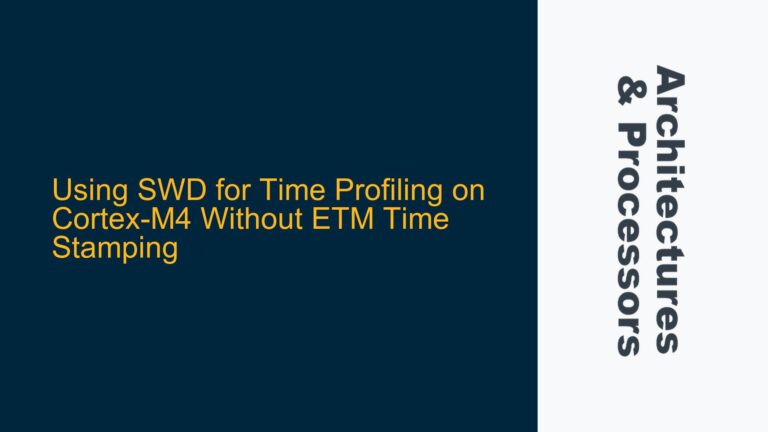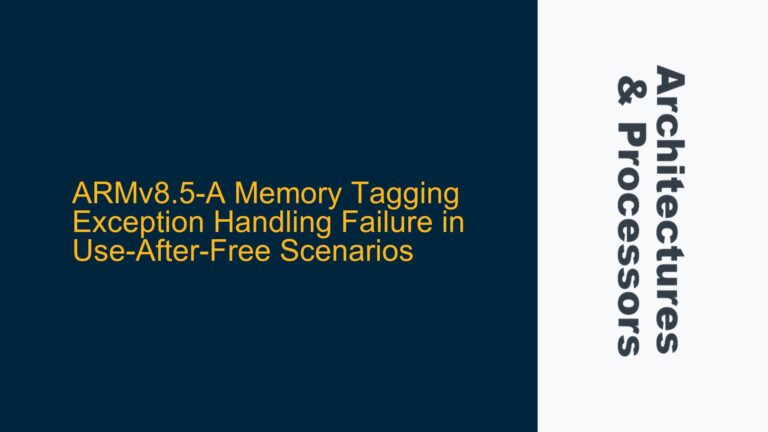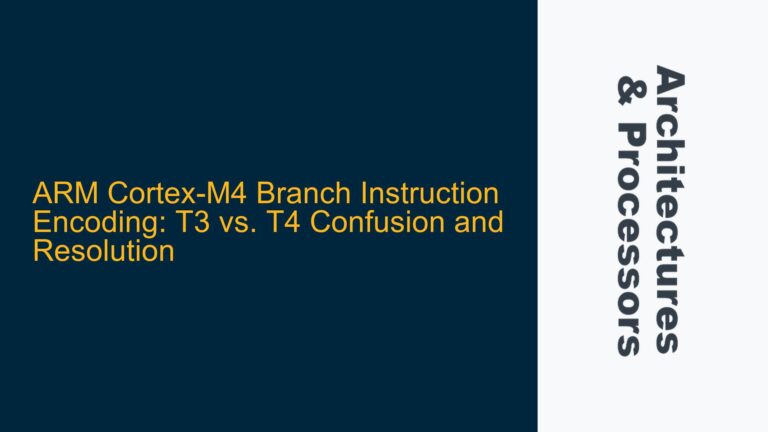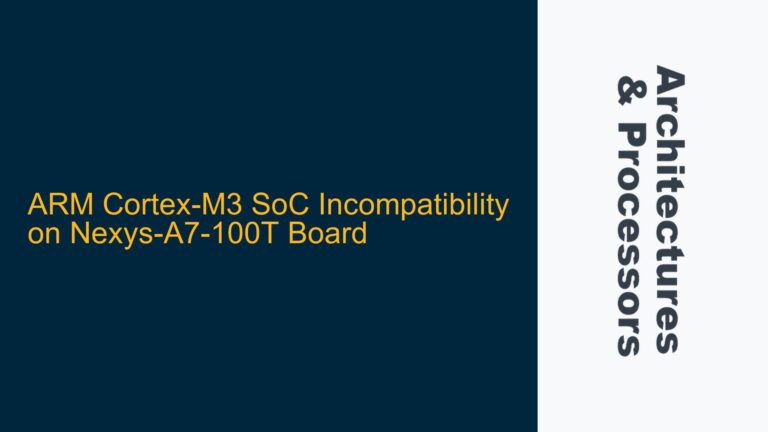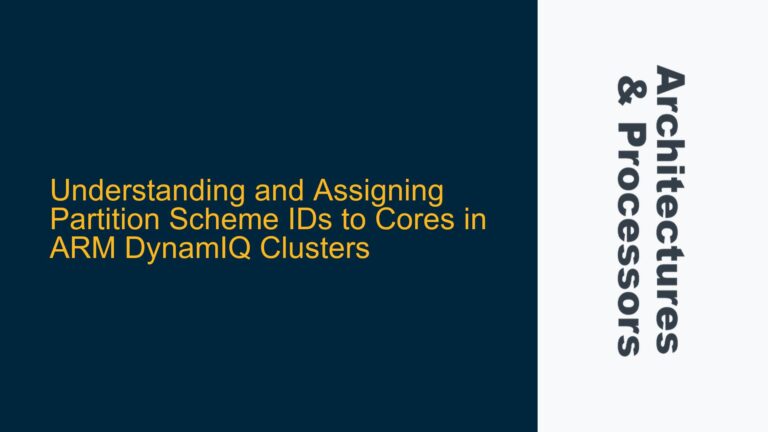ARM Cortex-M Memory Access and Conditional Branch Optimization
When working with ARM Cortex-M processors, efficiently testing the contents of a 16-bit memory cell for zero is a common task that can be optimized for both performance and code size. The ARM instruction set provides several mechanisms to achieve this, but understanding the nuances of memory access and conditional branching is critical to implementing the most elegant and efficient solution. The primary challenge lies in selecting the correct load instruction to access the 16-bit memory cell and combining it with the most efficient conditional branch mechanism.
The ARM architecture supports multiple load instructions, such as LDR, LDRH, and LDRSH, each tailored for specific data sizes and signedness. For 16-bit memory cells, the LDRH instruction is the appropriate choice, as it loads a halfword (16 bits) from memory into a register. Additionally, the ARM instruction set includes conditional branch instructions like CBNZ (Compare and Branch on Non-Zero) and CBZ (Compare and Branch on Zero), which eliminate the need for a separate comparison instruction, thereby reducing both code size and execution cycles.
The interaction between memory access and conditional branching is particularly important in embedded systems, where performance and resource constraints are often critical. Misalignment in memory access or inefficient branching can lead to suboptimal performance, especially in tight loops or real-time systems. Therefore, understanding the correct usage of these instructions and their impact on the pipeline and memory subsystem is essential for writing efficient ARM assembly code.
Incorrect Data Size Access and Redundant Comparison Instructions
One of the primary issues in the provided scenario is the use of the LDR instruction to load a 32-bit word instead of the intended 16-bit halfword. This discrepancy can lead to incorrect behavior if the memory layout or alignment assumptions are violated. For example, if the memory cell at the specified address is part of a larger data structure or array, loading a 32-bit word could inadvertently access adjacent memory locations, leading to unintended side effects or data corruption.
Another inefficiency arises from the use of separate CMP and BNE instructions to test the loaded value against zero. While this approach is functionally correct, it introduces unnecessary overhead in terms of both code size and execution time. The CMP instruction explicitly updates the condition flags, and the BNE instruction uses these flags to determine the branch outcome. However, ARM processors provide specialized instructions like CBZ and CBNZ that combine the comparison and branch operations into a single instruction, reducing the instruction count and improving pipeline efficiency.
The choice of instructions also impacts the processor’s pipeline and memory subsystem. For instance, the LDRH instruction ensures that only the required 16 bits are fetched from memory, minimizing memory bandwidth usage and avoiding potential alignment issues. Similarly, the CBZ instruction simplifies the control flow by eliminating the need for explicit flag manipulation, allowing the processor to execute the branch more efficiently.
Implementing Efficient 16-bit Memory Testing with LDRH and CBZ
To address the issues outlined above, the following steps provide a detailed guide to implementing an efficient and correct solution for testing the contents of a 16-bit memory cell for zero on ARM Cortex-M processors.
Step 1: Correct Memory Access with LDRH
The first step is to ensure that the correct data size is accessed from memory. The LDRH instruction should be used to load a 16-bit halfword from the specified memory address into a register. This instruction takes the form:
LDRH R0, [R4]
Here, R4 contains the address of the 16-bit memory cell, and R0 is the destination register. Using LDRH ensures that only the required 16 bits are loaded, avoiding potential issues with memory alignment or unintended access to adjacent memory locations.
Step 2: Combining Comparison and Branching with CBZ
Once the 16-bit value is loaded into a register, the next step is to test it for zero and branch accordingly. Instead of using separate CMP and BNE instructions, the CBZ instruction can be used to perform the comparison and branch in a single operation. The CBZ instruction takes the form:
CBZ R0, label
Here, R0 is the register containing the loaded 16-bit value, and label is the target address to branch to if the value is zero. This instruction eliminates the need for explicit flag manipulation and reduces the instruction count, resulting in more compact and efficient code.
Step 3: Handling Non-Zero Cases
If the value in the memory cell is non-zero, the program should continue execution without branching. The CBZ instruction inherently handles this case by falling through to the next instruction if the condition is not met. For example:
LDRH R0, [R4]
CBZ R0, zero_case
; Continue execution for non-zero case
B continue
zero_case:
; Handle zero case
continue:
; Resume normal execution
This structure ensures that the zero and non-zero cases are handled efficiently, with minimal overhead.
Step 4: Optimizing for Performance and Code Size
To further optimize the implementation, consider the following additional techniques:
- Register Allocation: Ensure that the registers used for the memory address and loaded value are chosen to minimize register pressure and avoid unnecessary spills to the stack.
- Instruction Scheduling: Arrange the instructions to maximize pipeline efficiency and minimize stalls. For example, placing unrelated instructions between the
LDRHandCBZinstructions can help hide memory access latency. - Loop Unrolling: If the memory test is performed within a loop, consider unrolling the loop to reduce branch overhead and improve instruction-level parallelism.
Step 5: Testing and Validation
Finally, thoroughly test the implementation to ensure correctness and performance. Use a debugger or simulator to verify that the LDRH instruction correctly loads the 16-bit value and that the CBZ instruction branches as expected. Additionally, measure the execution time and code size to confirm that the optimizations have achieved the desired results.
By following these steps, developers can implement an efficient and reliable solution for testing the contents of a 16-bit memory cell for zero on ARM Cortex-M processors. The use of LDRH and CBZ instructions ensures correct memory access and efficient conditional branching, while additional optimizations further enhance performance and code size. This approach is particularly valuable in resource-constrained embedded systems, where every cycle and byte counts.

